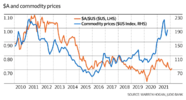I'm not sure how to work out, does the rise in the Australian Dollar vs The US Dollar benefit or hinder those in the commodities market? Specifically, miners like BHP and Rio, if the value of the AUD goes from .55c to .85 to the US dollar, does that mean the profit outlook for them is better or worse?
thanks
George T
thanks
George T

